In the beginning, dive watches were pure tools: essential swimming buddies that helped keep divers on time and hence, well, alive. Today they’re something else: fashion statements, conversation pieces, rugged companions for a trip to the beach or pool. This is an archive’s excerpt from Timeline: “Dive Watches Through the Decades,” which traces the history of the dive watch from its start in the 1920s, with the invention of the first truly water-resistant cases, to 2014. (Only mechanical watches are included.)
1. Rolex Oyster (1926)
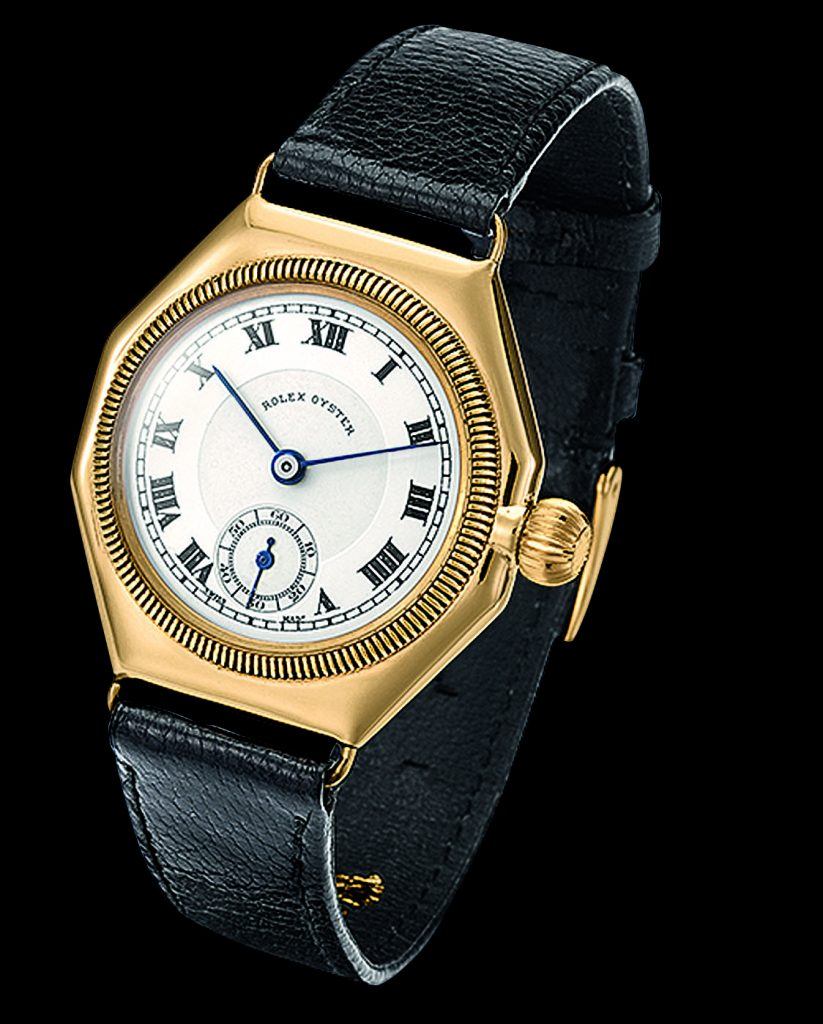
In 1926, watches constructed especially for use by divers appear. They have insulated crowns (the crown is the chief point of entry for water into a watch case). It was also the year that Rolex founder Hans Wilsdorf introduces the Oyster case, which has a screwed crown, screwed caseback, and securely sealing crystal. It is the world’s first truly water-resistant case. One year later, Wilsdorf asks Mercedes Gleitze, a stenographer vying to become the first British woman to swim the English Channel, to wear an Oyster on one of her attempts. She doesn’t make it all the way, but the Rolex she wears around her neck keeps on ticking.
2. Panerai prototypes (1936)
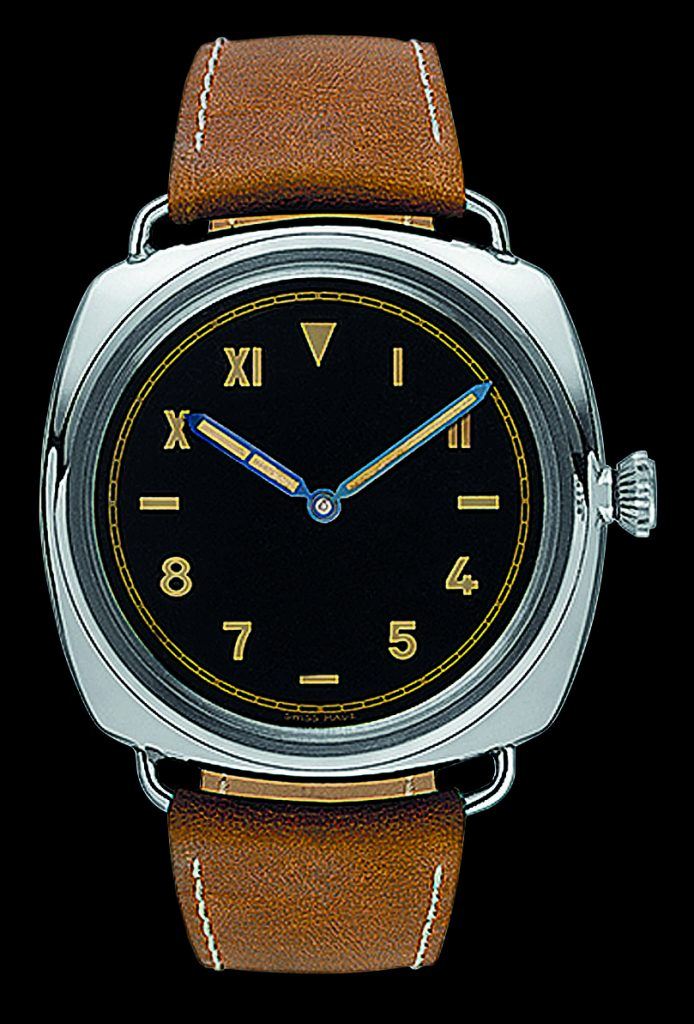
The Italian Navy commissions Panerai to develop the first prototypes of a watch that will evolve into the model now known as the “Radiomir.” The watches, water resistant to 30 meters, go into production two years later. The early Radiomir watches have movements and proprietary cases – cushion shaped and 47 mm in diameter − made by Rolex. They are named for the radium that makes their dials legible even in murky water.
3. Blancpain Fifty Fathoms (1953)
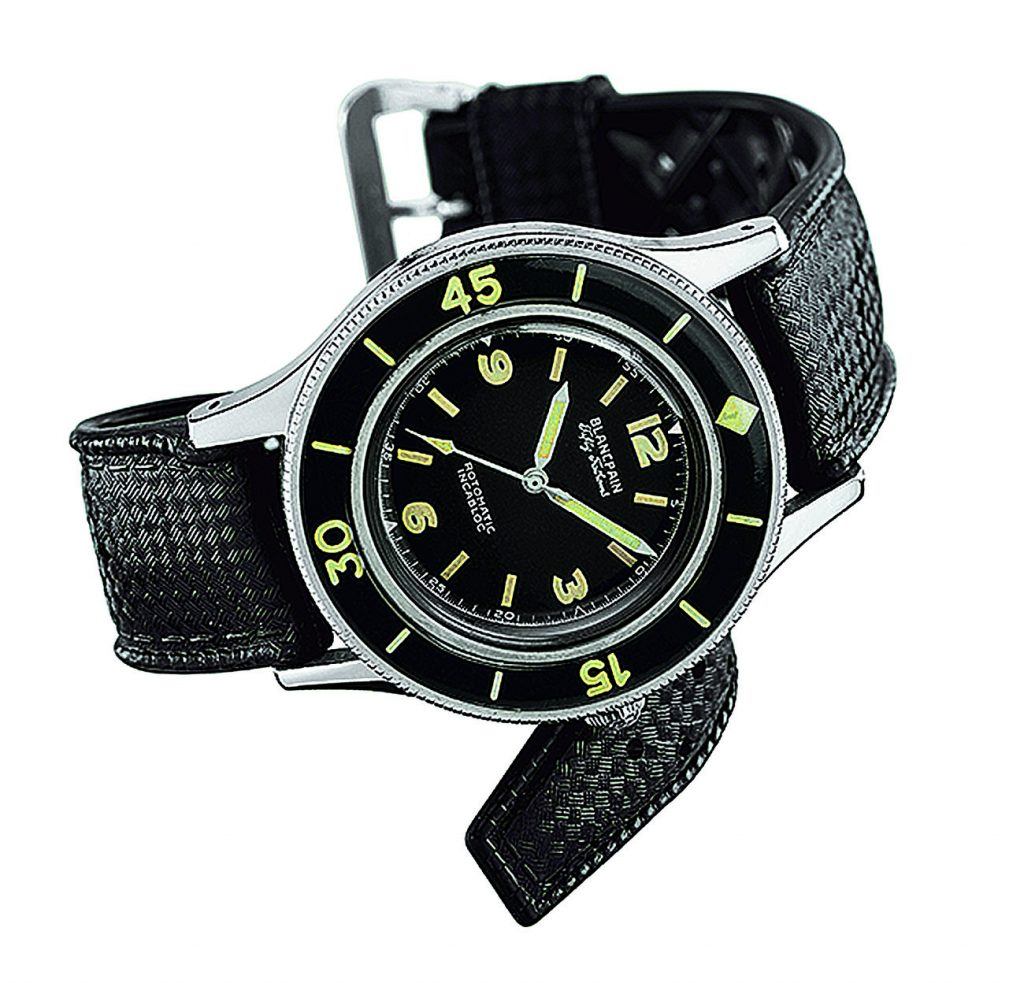
Blancpain presents its first dive watch, the Fifty Fathoms. The watch is water resistant to 100 meters. (Fifty fathoms is equal to 300 feet, or about 91 meters. It is the maximum depth divers can go at the time with the equipment then available.) The watch is the result of a request by Captain Bob Maloubier, who was a secret agent for the British during WWII and then became leader of the French military’s combat diving corps. He asked Blancpain to make a watch with a black dial, large Arabic numerals, clear indications and a rotating bezel. “We wanted in effect that each of the markers be as clear as a guiding star for a shepherd,” Maloubier later recalled.
4. Panerai crown protection (1956)
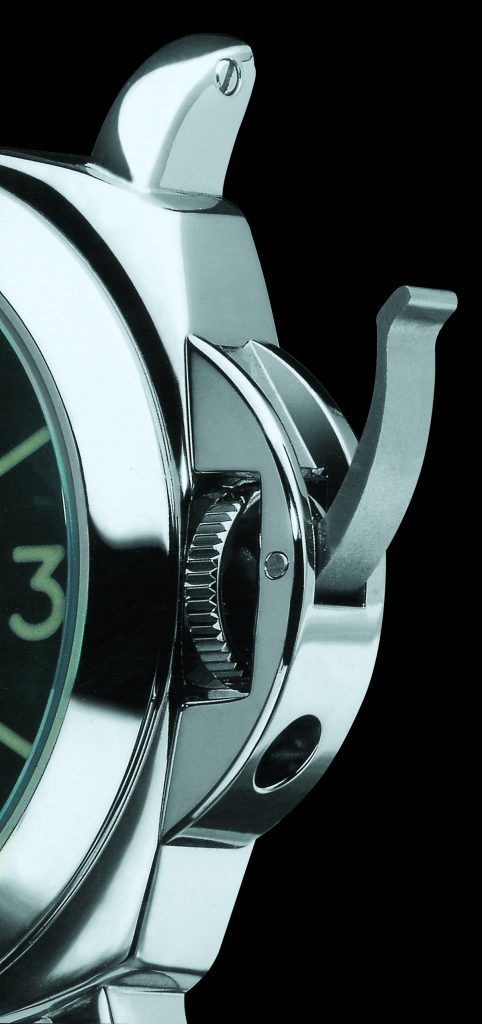
Panerai receives a patent for a curved, crown-protecting bridge. Now a hallmark of the company’s Luminor collection, the bridge contains a locking cam lever that pushes the crown against the case so that it fits tightly against the crown’s seals.
5. Breitling’s first dive watch (1957)
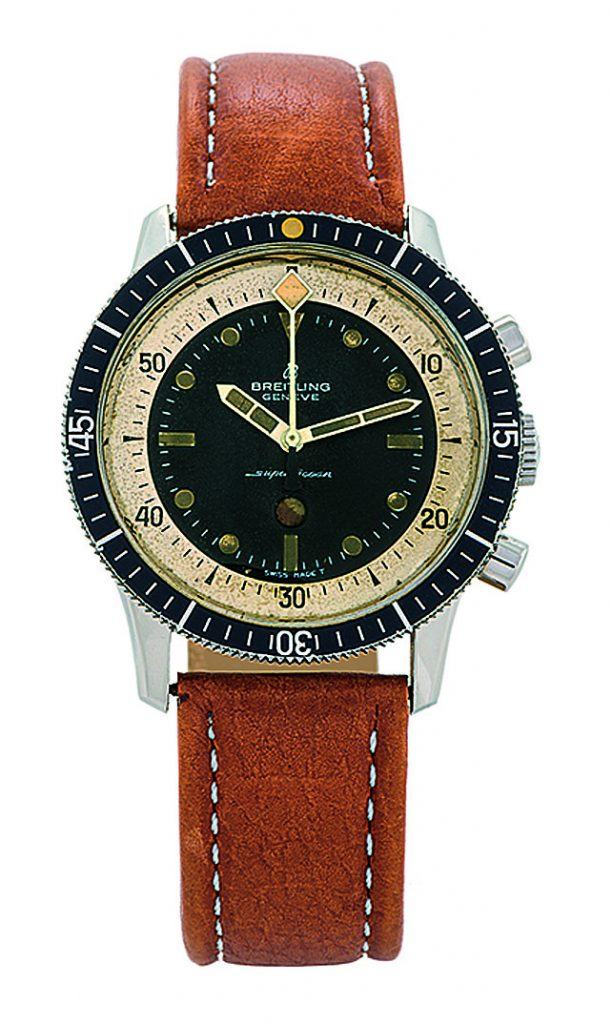
Breitling launches its first dive watch, the Superocean. The watch is water resistant to 200 meters, thanks in part to its monocoque (i.e., one-piece) case and its especially sturdy crystal. The watch’s bezel can be locked in place so that it won’t be knocked off position during a dive. A chronograph version of the watch comes out in 1959.
6. First Rolex Sea-Dweller (1967)
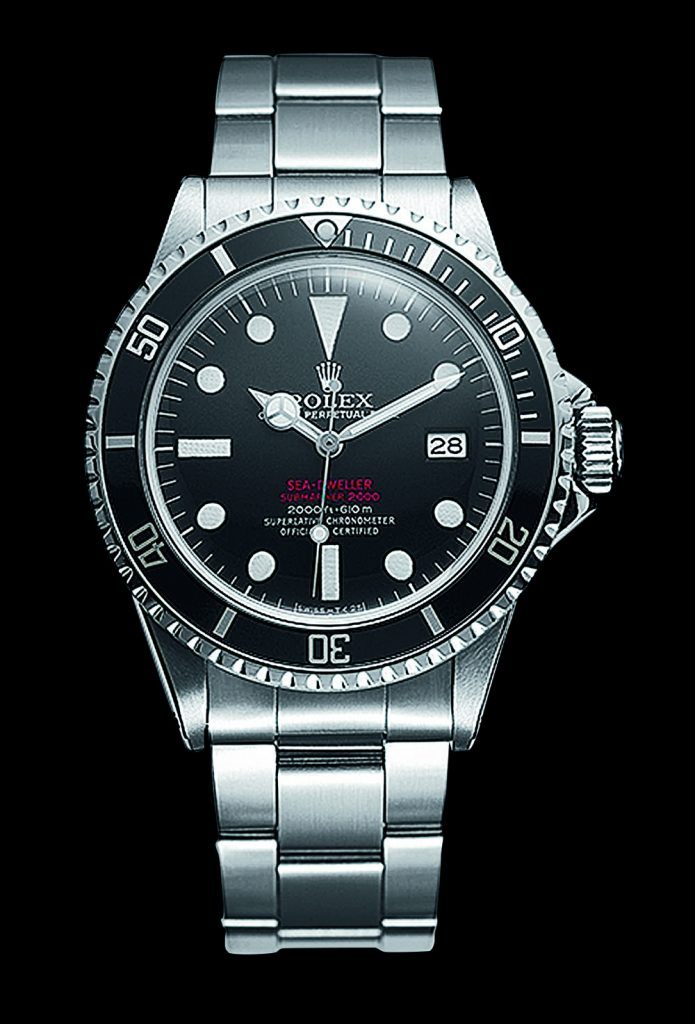
Rolex introduces the Sea-Dweller, a deeper-diving version of the Submariner. Its distinguishing feature is its helium valve, through which helium that has entered the watch case during time spent in a diving chamber can be released. The watch is produced at the request of the French company COMEX (Compagnie Maritime d’Expertise), which specializes in deep-diving equipment and services, chiefly for offshore oil and gas extraction. The watch is water-resistant to 610 meters.
7. First dive computer (1983)
The first dive computer is introduced. In the 1990s, the use of dive computers becomes widespread, and dive watches are relegated chiefly to the role of back-up equipment.
8. ISO invents dive watch standard (1996)
The International Organization for Standardization (ISO) issues standard 6425, defining the features that a watch must have in order for it to be designated a “dive” watch. They include requirements for water resistance (the watch must be 25 percent more water-resistant than claimed on the dial), legibility under water, resistance to thermal shocks and ability to measure elapsed time. Standard 6425 supplants the standard issued in 1984 and is still in effect today.
9. CX Swiss Military 20,000 Feet (2009)
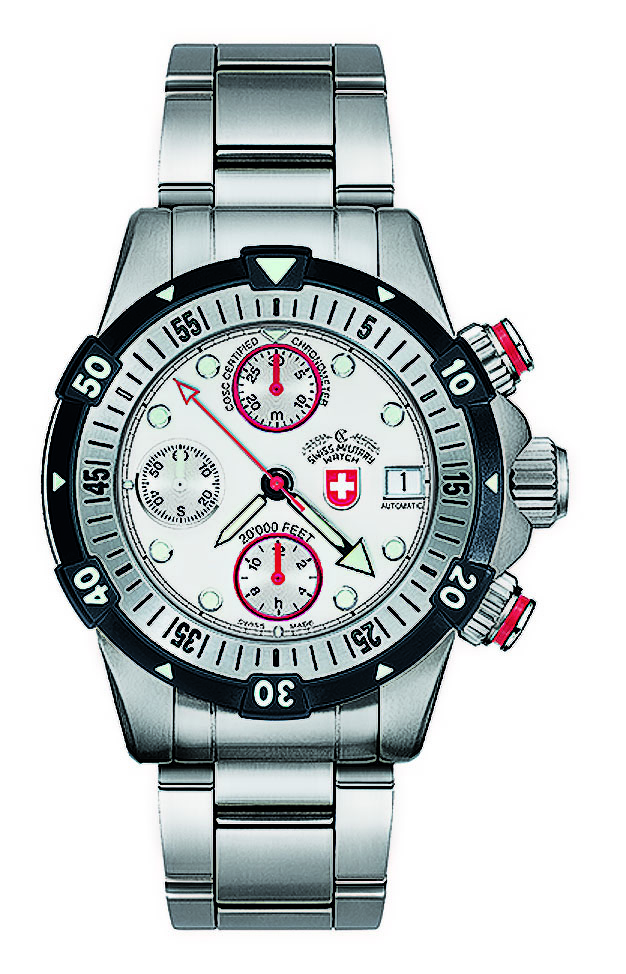
CX Swiss Military unveils the 20,000 Feet, which breaks the Rolex Deepsea’s record for water resistance (20,000 feet is equal to about 6,100 meters) and enters the Guinness Book of Records. (CX Swiss Military had held the deepness record from 2005 until the Deepsea appeared in 2008.) The watch is a chronograph with a 28.5-mm-thick case and a domed back. According to CX Swiss Military, it is actually water-resistant to 7,500 meters, thus providing the 25-percent margin of safety required to meet ISO 6425.
10. IWC Aquatimer collection (2014)
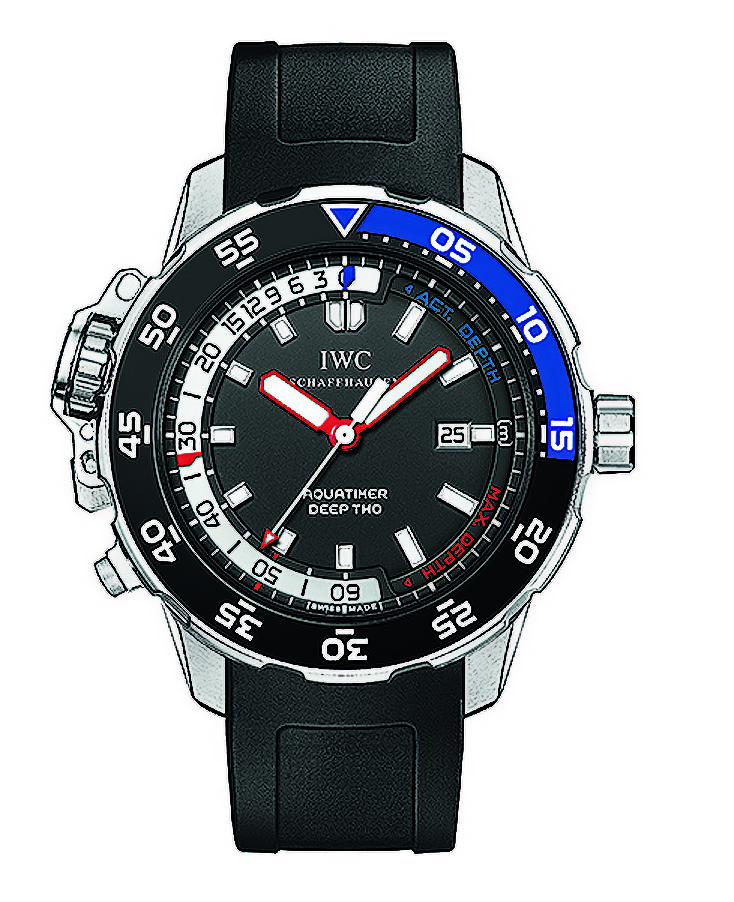
IWC updates its Aquatimer collection, fitting it with an outer, bidirectional bezel and an inner, unidirectional one. The most impermeable of the new Aquatimer models, the Aquatimer Automatic 2000, is water resistant to 2,000 meters.
Discover the complete history of the dive watch in our download — available in the WatchTime Shop — which includes even more highlights and firsts, like the Rolex Sea-Dweller 4000 and the first Omega Seamaster!




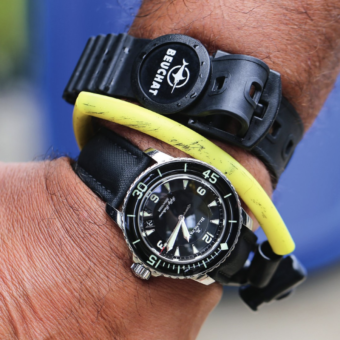


The ITALIEN Naivy PANERAI – PAMPRO04 1936 IS THE MOST Elegant – Traditional Style Watch –
The Panerai 1936 is a Very Traditionan Style
Ofcourse The Rolex Oyster Ref. 679. 192
is a Master Pease
How Can y Buy the PANERAI / RADIOMIR ?
IS IT POSIBLE TU BUY IT buy ” INTERNET ” :??
Enjoyed your article, my first watch for my hobby was breitling Super Ocean
What about the Omega PloProf
Why can I not open the responses already published?
I still Love my WRX Ralf Tech .
Scuba & swim then Shower to wash off Salty Grime . Got 2 watch bands Silicon.
Stainless Steel 316 L . Engineers Screwed Links . Not Pressure Pins .
Wow, not one Omega in the lineup?!
Not the Omega Marine of 1932 which was the first commercially available dive watch and the first to be tested at over 100m.
Not the Ploprof
Not the Seamaster 120m of 1972 and the first to have chronograph pushers that work under water.
Your list has gaping holes!
Great info. Please keep it coming. Im new at this watch thing but Im enjoying the trejectory of learning and Im getting a little collection of nice watches too.
The visitors of this magazine are watch experts.
The information consolidate to clean up mistakes.
Not calling the Omega Seamaster in the article is a mistake, but corrected by the comments.
And saying that, i am loving my Seamaster. Honestly said, i use it as a desk diver.
My Seamaster even open up my interest in dive watches, also the dive watches from other brands.
I am coming from dress watches, and never thought about wear a diver watch. I thought, ok, i have some watches, why not get a diver watch? So, by looking at brands i came in touch with Omega. I fell on the dial design, good experience with Swatch group watches, red about the less friction co-axial movement which is very accurate.
The IWC Aquatimer had some things why i do not wanted that watch. The Panerai looks odd in my eyes with that small second hand and bulky crown gard.
The Blancpain fifty fathoms and the bathyscaphe are high end divers which is interesting.
Nice article. Unfortunately, you got it wrong on the Fifty Fathoms. It was engiineered at 300 feet, not 10 atm. The Zodiac Sea Wolf was released right along side the Blancpain and had a rating of 10atm. The Blancpain and Zodiac are the first dive watches with moveable bezel. Funny how all the articles leave out Zodiac….
Having read all the comments it would appear that the dive watch has a huge following and most have a favourite. Surely it’s time someone produced an affordable book on the subject.
I think the Omega Marine should have had a mention as the first commercially available divers watch in 1932, their Seamaster range from 1957 and the fact that Rolex has to use Omegas designs for their watches supplied to the Navy as the Omega was a superior watch.
The 1967 development of the Helium escape valve was a joint initiative of Doxa and Rolex. The Rolex however was not initially available for public purchase whereas the Doxa was. Hense as far as the consumer is conserned the Doxa was first. And as usual you have omitted Tudor. At the time of its release at the 1954 Baselworld both it and Rolex were owned by Hans Wilsdorf. So it was not a second watch under Rolex but a separate brand by Hans Wilsdorf.
You cannot speak about the “history” of a dive watch without mentioning Omega’s groundbreaking, first ever commercial dive watch, and the many pieces that were used commercially afterward.
https://www.omegawatches.com/en-us/chronicle/1932-wet-and-dry-precision
http://www.elitedivingagency.com/articles/dive-watch-history/
Great article… I know you’re not going to please all the people, all of the time, but surely Favre Leuba deserves a mention for their Deep Blue?
No mention of Citizen Aqualand which are one of the best dive watches out there with features no other Swiss watches have
What about the omega Ploprof?
Wow! No mention of Seikos HUGE contribution to the Dive Watch???
you missed the Favre-Leuba Deep Blue and the Bathy, which are milestone watches for divers.
I love your publication so let’s start with that. I am concerned however when an article that pretends to be an informal historical piece becomes a product placement add for the usual brands that are always highlighted: Rolex, Panerai, IWC ( minimal historical relevance, yet ever present regardless of topic) and Breitling. In my opinion, your readers would appreciate more coverages of perhaps less commercial and more interesting and relevant brands.
Nice collection indeed. I would mention as well:
Omega SeaMaster “BigBlue” and Jaeger LeCoultre Master Compressor series
I’d have thought that seiko would have gotten a mention, given their huge groundbreaking contributions to dive watches
Dive watches are technical subject matter. This article is not. You leave out the Doxa SUB with its no-deco bezel, and instead include a random, modern IWC? If you’re going to mail it in with a listicle, at least bear a consistent theme.
How did Omega get left off this list? Their first dive watch was made in 1932. Their first modern diver with a rotating bezel was 1957.
Agreed!
OMEGA invented the world first commercially available dive watch in 1932, it was called the OMEGA Marine.
Every article I read about dive watch history mentions Rolex and the invention of the helium release valve but omits Doxa watch and their part in that invention. Everything that I have read mentions Doxa and Rolex shared the patent on that feature. Is Doxa just a poor cousin that is overshadowed by Rolex? I wear a sub 1200 and my wife wears a Rolex that I gave her as an engagement present. Both are great brands but it seams Doxa usually gets left out. Maybe I’m off base but I usually notice articles about Doxa, Rolex and dive watches in general. Just an observation. Great publication as always.
Couldn’t any of ORIS watches make the cut?
What about the Omega Seamaster ???
Why isn’t the Submarine Watch, made by Tavannes in 1917, not mentioned as the first water-resistant case? As it was referenced as such from The Horological Journal, December 1917.
Very interesting article. The Swiss Military, good to 20,000 feet looks like it was made by Rolex. What is your assessment?
WAIT A SECOND HERE…
You have published an article on the “10 Highlights in the History of the Dive Watch” and somehow missed the Seiko Tuna which revolutionized so much with all its patents and the Squale 1521 which revolutionized case and crown position and has been copied a million times since? Yet pointed to a completely irrelevant Brietling and a current IWC which offers nothing of note??? Who wrote this?
Thanks for the feedback. The “Tuna” is in fact an extremely important milestone when it comes to the evolution of the dive watch. It is in fact so important that we already covered it extensively several times here on WatchTime.com and wanted to highlight different aspects in this article you commented on:
https://www.watchtime.com/blog/dive-watch-wednesday-introducing-the-seiko-prospex-marinemaster-1000/
https://www.watchtime.com/blog/dive-watch-wednesday-saturation-diving-helium-valves-and-extreme-dive-watches/
https://www.watchtime.com/blog/explaining-the-seiko-6159-7010-grandfather-tuna/
https://www.watchtime.com/featured/vintage-eye-for-the-modern-guy-seiko-marinemaster-professional-1000m/